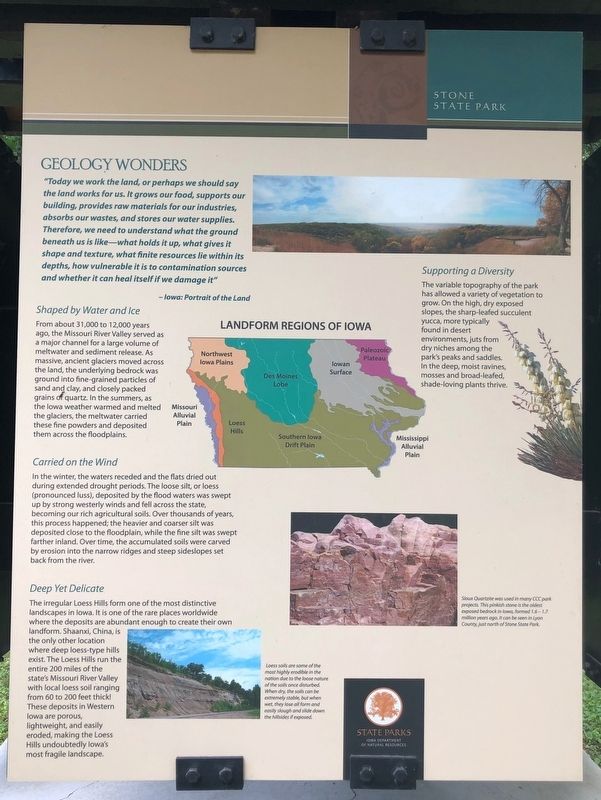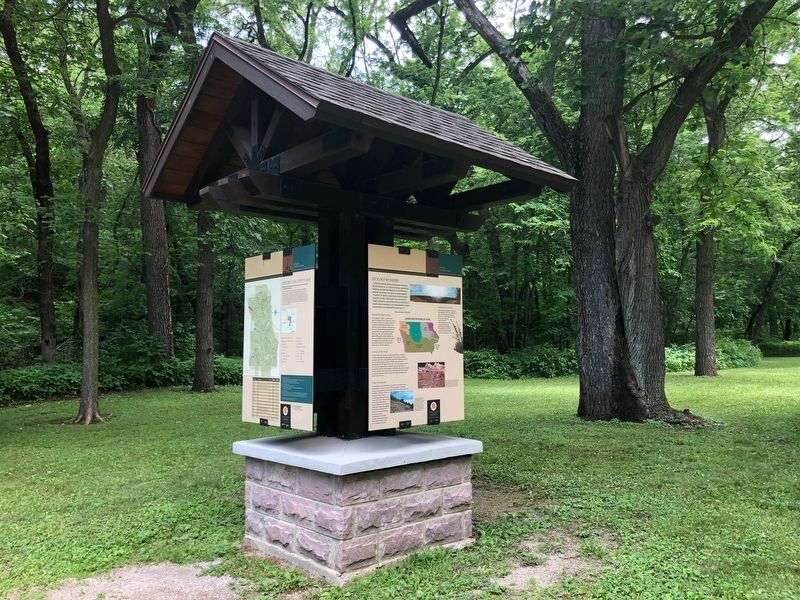Sioux City in Woodbury County, Iowa — The American Midwest (Upper Plains)
Geology Wonders
Stone State Park
"Today we work the land, or perhaps we should say the land works for us. It grows our food, supports our building, provides row materials for our industries, absorbs our wastes, and stores our water supplies. Therefore, we need to understand what the ground beneath us is like - what holds it up, what gives it shape and texture, what finite resources lie within its depths, how vulnerable it is to contamination sources and whether it can heal itself if we damage it.
- Iowa: Portrait of the Land
Shaped by Water and Ice
From about 31,000 to 12,000 years ago the Missouri River Valley served as a major channel for a large volume of meltwater and sediment release. As massive, ancient glaciers moved across the land, the underlying bedrock was ground into fine-grained particles of sand and clay, and closely packed grains of quartz. In the summers, as the Iowa weather warmed and melted the glaciers, the meltwater carried these fine powders and deposited them across he floodplains.
Carried on the Wind
In the winter, the waters receded and the flats dried out during extended drought periods. The loose silt, or loess (pronounced luss), deposited by the flood waters was swept up by strong westerly winds and fell across the state, becoming our rich agricultural soils;. Over thousands of years, this process happened; the heavier and coarser silt was deposited close to the floodplain while the fine silt was swept farther inland. Over time, the accumulated soils were carved by erosion into the narrow ridges and steep sideslopes set back from the river.
Deep Yet Delicate
The irregular Loess Hills form one of the most distinctive landscapes in Iowa. It is one of the rare places worldwide where the deposits are abundant enough to create their own landform. Shaanxi, China, is the only other location where deep loess-type hills exist. The Loess Hills run the entire 200 miles of the state's Missouri River Valley with local loess soil ranging from 60 to 200 feet thick! These deposits in Western Iowa are porous, lightweight, and easily eroded, making the Loess Hills undoubtedly Iowa's most fragile landscape.
Supporting a Diversity
The variable topography of the park has allowed a variety of vegetation to grow. On the high, dry exposed slopes, the sharp-leafed succulent yucca, more typically found in desert environments, juts from dry niches among the park's peaks and saddles. In the deep, moist ravines, mosses and broad-leafed, shade-loving plants thrive.
Picture Captions:
Sioux Quartzite was used in many CCC park projects. This pinkish stone is the oldest exposed bedrock in Iowa. Formed 1.6 - 1.7 million years ago. It can be seen in Lyon County, just north of Stone State Park.
Loess soils are some of the most highly erodible in the nation due to the loose nature of the soils once disturbed. When dry, the soils can be extremely stable, but when wet, they lose all form and easily slough and slide down the hillsides if exposed.
Erected by State Parks Iowa Department of Natural Resources.
Topics. This historical marker is listed in these topic lists: Environment • Parks & Recreational Areas.
Location. 42° 33.428′ N, 96° 28.511′ W. Marker is in Sioux City, Iowa, in Woodbury County. Marker is on Stone State Park Dr. Located at the western entrance to Stone State Park. . Touch for map. Marker is in this post office area: Sioux City IA 51109, United States of America. Touch for directions.
Other nearby markers. At least 8 other markers are within 5 miles of this marker, measured as the crow flies. From Settlement to State Park (here, next to this marker); Native Peoples of the Loess (a few steps from this marker); An American Treasure (approx. 0.2 miles away); Prairies in the Hills (approx. 0.3 miles away); Big Sioux River Valley (approx. 0.3 miles away); You Are Entering South Dakota (approx. 2.2 miles away in South Dakota); Grand Army of the Republic (approx. 4.4 miles away); Twelve Mile House (approx. 5 miles away in South Dakota). Touch for a list and map of all markers in Sioux City.
Credits. This page was last revised on August 8, 2020. It was originally submitted on July 10, 2019, by Ruth VanSteenwyk of Aberdeen, South Dakota. This page has been viewed 247 times since then and 14 times this year. Photos: 1, 2. submitted on July 10, 2019, by Ruth VanSteenwyk of Aberdeen, South Dakota. • Bill Pfingsten was the editor who published this page.

